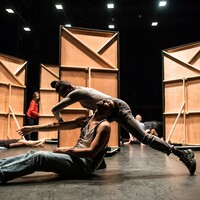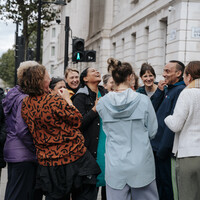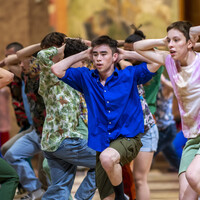Dance in the community with Rosetta Life
News Story

How can dance improve the lives of people who are living with the effects of stroke or a brain injury?Here’s how students from London Contemporary Dance School bring their practice into the community with the charity, Rosetta Life.
At London Contemporary Dance School (LCDS), it’s important that we enable our students to become versatile, lifelong dance artists and practitioners. Crucially, the dance skills and creative knowledge they acquire isn’t limited to performing on-stage. People know us as a prestigious dance school that cares, and we’re not afraid to push the boundaries of what can become possible with dance.
Rosetta Life is a charity focused on bringing the arts into health innovation. Founded in 1997, the team started with a programme of movement and storytelling with people in palliative care. They went on to work on a related campaign with the National Theatre, and grew their dance theatre programmes, which includes a partnership with the National Hospital for Neurology and Neurosurgery. Brain Odysseys (previously Stroke Odysseys) is one of the charity’s initiatives, which is a performance arts programme for people living with the effects of stroke or brain injury. Graduates from these programmes go on to become ambassadors, running their own performance arts programmes and advocating for independent life after stroke.
During the second year of the BA (Hons) Contemporary Dance Performance course, students have the opportunity to experience Rosetta Life’s work through a five week placement interacting with the Brain Odysseys ambassadors.
Students on the MA Dance: Participation, Communities, Activism course also experience this work through two in-person residencies at The Place, with the rest of the course being delivered online to ensure our students remain embedded within the communities with whom they work across the world.
Dance is transformational
“Dance is a relational practice; it can be a creative act of care,” said Lucinda Jarrett, Co-Founder and Creative Director of Rosetta Life. “The role of creative care in creating a listening, empathetic, tolerant, inclusive and visible space in our communities is really important. Dance connects us with each other. Getting involved with our work enables students to look at their own career and professional journey, and think about what dance might mean to society at large, and how an applied dance practice might contribute to social change.”
Brain Odysseys was developed following a four-yearpractice research project to study, test and implement a performance arts model for neurological rehabilitation. It was led by Rosetta Life in collaboration with several hospitals. The results were compelling. Following weekly hour-long sessions, dance raised the energy levels of participants, contributed to optimism and hope after the trauma of a stroke, and helped people remember who they were.
When LCDS students and Brain Odysseys ambassadors come together on this project, the focus is on co-creation. “The ambassadors are bringing their bodies, stories, feelings, senses and ideas,” Lucinda said. “The students are bringing dance ideas to human stories instead of exploring choreographic themes in a professional arts practice. But their roles converge as they learn from each other. Students start to really think about how they can help the ambassadors show themselves as fully human in a world which marginalises, stigmatises and silences them. When they discuss possible dance pieces, the ambassadors have ideas about what is possible, and what feels honest and authentic to them. Together they work on the equality of leadership and exchange. Social change is made manifest in the process, as the ambassadors become more visible to themselves, and the students become part of an inclusive choreographic co-creation practice.”
This work culminates in different ways, including in performances at The Place. In 2024, LCDS students took part in a performance with the ambassadors in Queen Square, outside the National Hospital for Neurology and Neurosurgery.
“It's important for students – who see their bodies as elite athletes, masters of technique and expression – to see that even when people have paralysis and only partial movement, there can be a dance that is one of recovery, joy, healing and health,”Lucinda said.
Dance is a relational practice; it can be a creative act of care.
Lucinda Jarrett, Co-Founder and Creative Director of Rosetta Life
Opening up the future
A number of students have progressed to work on a range of related projects after their experiences with Rosetta Life. Some have been invited to work on projects with dance companies associated with the charity. One student was employed by Rosetta Life for three months to work on a professional performance piece funded by the Arts Council.
“Many students ask how they can continue working with us after the collaboration finishes,” Lucinda said. “Some of them have re-thought their professional careers and actively look for work in this space. Others have told me how it was transformational to their thinking of their career as a dancer. I think it’s been quite a profound experience for many people.”
Lucinda also believes the LCDS ethos for pushing the boundaries complements the work of Rosetta Life. “There’s real prestige and energy around LCDS and the school’s way of thinking,” she explained. “We become part of that teaching, so we begin to recognise our practice as a radical act, and see this made visible. There's a huge joy in working with the energy of the students at LCDS. And they support the performance in ways the ambassadors couldn't manage on their own.”
Bringing new perspectives on dance and its value can be instrumental to how students shape their futures. ““I’ve noticed how the teaching and the support for students at LCDS is very good. So much of dance training is around technique, improvement, alignment and punishing routines,” Lucinda said. “Sometimes those who work in dance can forget the importance of joy, practices seeking pathways to healthy minds and bodies, kinship, and connection in dance practice. I think the work we do with students helps them remember this. LCDS is a brilliant partner to work with and I’ve enjoyed every minute of it.”
It's important for students – who see their bodies as elite athletes, masters of technique and expression – to see that even when people have paralysis and only partial movement, there can be a dance that is one of recovery, joy, healing and health.


